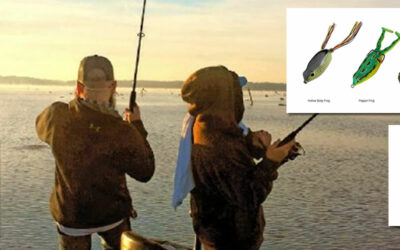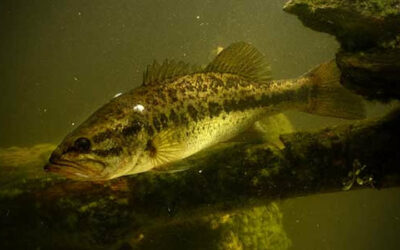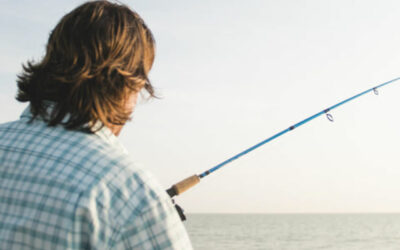Winter bass fishing presents a unique challenge for many anglers, as these cold-blooded creatures become less active and harder to catch in colder waters. But with the right knowledge, techniques, and lures, you can master the art of winter fishing for bass and reel in some impressive catches.
In this blog post, we will explore the effects of cold water on bass, their winter habitat, and feeding habits, as well as the top lures and techniques for winter fishing success. So put on your warmest gear and let’s dive into the frigid waters of winter fishing.
Key Takeaways
-
Master the art of winter fishing with special lures and techniques for deeper waters.
-
Identify preferred habitats, such as creek channels and steep banks, to target bass in cold water conditions.
-
Utilize slow retrieves, vertical jigging, and finesse tactics while dressed appropriately & using electronics for best results.
Cold Water Bass Fishing Basics
Cold water fishing presents a unique set of challenges for bass anglers. The metabolism of bass slows down in colder waters, which decreases their requirement for sustenance and alters their feeding habits. As water temperatures drop, bass become less active and move to deeper waters in search of more stable conditions.
So, how can you catch bass in such challenging conditions? Grasping the basics of cold water bass and opting for suitable bass lures and techniques can steer the odds to your favor, paving the way for a fulfilling fishing experience.
During winter, bass tend to prefer deeper water and are often found suspended in the water column. These lethargic fish gravitate towards stable water temperatures and areas with depths of less than 20 feet.
Catching bass lurking in these icy waters requires the selection of appropriate lures and techniques to effectively engage the suspended fish and stimulate their feeding instincts. The following sections delve into an array of lures and techniques recognized for their effectiveness in winter fishing.
Water Temperature and Bass Metabolism
The metabolism of bass is directly influenced by decreasing temperatures. As the water temperature drops, their metabolic rate slows down, making them less active and less likely to feed. Consequently, during winter, selecting lures and techniques capable of effectively engaging these less active fish and coaxing them to bite is vital.
The ideal water temperatures for bass activity during winter are generally between 45 to 50 degrees Fahrenheit. In these conditions, bass will usually move to deep water where they will stay for the majority of the winter.
Anglers must factor in these temperature aspects when devising their winter fishing strategies. Knowing the preferred temperature range of bass can help you locate their winter habitats and increase your chances of success on the water.
Winter Bass Habitat
During the winter months, largemouth bass change their habitat preferences and move to deeper water structures, creek channels, and steep banks. These locations provide them with a more stable and consistent temperature, which is crucial for their survival in cold conditions.
Discovering and focusing on these habitats can notably enhance your likelihood of catching bass in cold water.
Bass typically inhabits creek channels and points to winter areas, as well as deeper river and creek channels during the coldest times of winter. As bass anglers, acquainting yourself with the local waterways and staying alert for these critical habitats is imperative.
By understanding where bass are likely to congregate during winter, you can increase your chances of successfully targeting and catching them.
Winter Feeding Habits & Bass Lures
In chilly water, largemouth bass are more likely to target slow-moving prey due to their decreased metabolic rate. This necessitates the choice of lures that mimic slow-moving prey and harmonize with your hatch.
By presenting a realistic and appealing lure, you can increase your chances of attracting and catching bass in cold water conditions.
Some effective bass lures for winter fishing include suspending jerkbaits and finesse worms rigged weightless Texas-style or drop-shot style. Jerkbaits are particularly effective in frigid water conditions, as they simulate the appearance of a distressed or expiring shad.
The drop-shot technique allows the lure to remain in the vicinity of inactive bass for an extended period, increasing the likelihood of a strike.
By using lures that effectively mimic the winter feeding habits of largemouth bass, you can improve your chances of success on the water.
Top Lures for Winter Bass Fishing Success
Selecting the right lure is crucial for winter bass fishing success. With the right lure, you can proficiently engage bass in their favored winter habitats and stimulate their feeding instincts. This section outlines some of the premiers bass lures for winter fishing success, encompassing soft plastic baits, crankbaits, and jerkbaits, along with jigs and spinnerbaits.
Knowing which lures are most effective in brisk water conditions can help you increase your chances of catching bass during winter. By tailoring your lure selection to the specific conditions and habits of bass during this season, you can optimize your fishing strategy and maximize your success on the water.
Soft Plastic Baits to Catch Bass
Soft plastic baits, such as finesse worms and drop shot rigs, are versatile and effective options for winter bass fishing. These baits can be used in various depths and conditions, making them a valuable addition to any angler’s tackle box.
Some recommended soft plastic baits for winter bass fishing include:
-
Soft-plastic jerkbaits
-
Swimbaits
-
Grubs
-
Tubes
-
Spider grubs
-
Craws
-
Ned Rigs
When rigging a drop shot rig, it’s important to use special drop shot hooks and sinkers designed for this technique and rig the hook 1 to 2 feet above the weight to keep the plastic bait suspended just off the bottom. By using soft plastic baits effectively, you can target bass in their preferred winter habitats and entice bites in nippy water conditions.
Crankbaits and Jerkbaits
Crankbaits and jerkbaits, such as suspending jerkbaits and lipless crankbaits, are ideal bass lures for imitating baitfish and triggering reaction strikes from bass in intense chilled water.
These lures are designed to replicate the movement and appearance of baitfish, making them highly effective in enticing bites from less active bass during lipless crankbait fishing.
When using a jerkbait for winter bass fishing, it’s important to modify your cadence and avoid a consistent, jerking motion. Experiment with different twitches and pauses to elicit a response from the fish.
Similarly, when using a lipless crankbait, choose a lure that suspends effectively in cooler water, and use a slow, steady retrieve to mimic the movement of prey in the water column.
By using crankbaits and jerkbaits effectively, you can increase your chances of catching the biggest fish in cold water conditions.
Jigs and Spinnerbaits
Jigs and spinnerbaits, such as football jigs and Colorado blade spinnerbaits, are great options for targeting bass in deep water and around structures. These lures can be fished at various depths and around various cover types, making them a versatile choice for winter bass fishing.
When using a football jig, it’s important to maintain constant bottom contact while slowly dragging it along the lake bed. Spinnerbaits, on the other hand, can be slow-rolled near vertical cover and are particularly effective in transmitting vibrations in bitter cool water.
By using jigs and spinnerbaits effectively, you can target bass in their preferred winter habitats and increase your chances of success on the water.
Winter Bass Fishing Techniques
In addition to selecting the right lures, it’s essential to employ effective techniques when winter bass fishing. This section examines various techniques that can assist you in catching bass under bleak water conditions, including slow and steady retrieves, vertical jigging, and finesse tactics.
By mastering these techniques and adapting them to the specific conditions and habits of bass during the winter months, you can increase your chances of success on the water and enjoy a rewarding fishing adventure experience.
Slow and Steady Retrieves
A slow and steady retrieve is essential for winter bass fishing success, as bass are less active and more likely to strike slow-moving lures. By adjusting your retrieval speed and technique, you can effectively target these lethargic fish and increase your chances of catching big bass in chilled crisp water conditions.
One effective technique for slow and steady retrieves is bottom bouncing with grubs, where a lightweight jig head is used to keep the grub near the lake bed, mimicking the motion of aquatic insects and small prey. By using slow and steady retrieval techniques, you can effectively target bass in their preferred winter habitats and entice them to bite.
Vertical Jigging
Vertical jigging with lures like jigging spoons and blade baits can be an effective technique for targeting deepwater bass during winter. By fishing vertically and experimenting with various cadences, you can induce bites from bass in their winter habitats.
The optimal depth for vertical jigging for bass during the winter season may vary, but a depth of 20 feet or more is typically recommended.
By positioning your boat over a target and dropping the jigging spoon straight down to the desired depth, you can effectively target bass in deep water and increase your chances of success on the water.
Finesse Tactics
Finesse tactics, such as using a Ned Rig, hair jig, or blade bait, can help entice bites from finicky bass in wintry water. These subtle presentations can effectively mimic the movement of prey and trigger strikes from less active bass.
When using finesse tactics like a Ned Rig, vertical jigging, casting and retrieving through the water column, and slowly crawling and hopping along the bottom are all effective techniques. By employing finesse tactics in your winter bass fishing strategy, you can increase your chances of catching a few bass in frigid water conditions.
Tips for Winter Bass Fishing Success
In addition to selecting the right lures and techniques, there are several other factors that can contribute to your winter bass fishing success. This section provides tips on maintaining comfort on the water, employing electronics for bass location, and upholding patience and persistence throughout your fishing escapade.
By incorporating these tips into your winter bass fishing strategy, you can optimize your time on the water and increase your chances of success.
Dress Appropriately
Dressing appropriately for cold weather conditions is crucial for staying comfortable and focused while winter bass fishing. Here are some tips for layering your clothing:
-
Start with thermal underwear.
-
Follow with wool socks.
-
Add a polar fleece vest.
-
Layer a polar fleece long sleeve jacket on top.
-
Wear polar fleece pants.
-
Finish with rain gear.
Layering your clothing in this way will help ensure you remain warm and comfortable while fishing.
Dressing appropriately can allow you to stay concentrated on the task and optimize your probability of success on the water.
Use Electronics
Utilizing electronics, such as fish finders and GPS, can help you locate bass and their preferred habitats during winter. These tools enable you to pinpoint fish in deeper water, recognize their behavior, and present a visual representation of fish beneath the surface.
Effective use of electronics can elevate your likelihood of locating and catching bass under intense water conditions.
Be Patient and Persistent
Being patient and persistent is key to winter bass fishing success, as bass may be less active and more difficult to catch in bitter cool water. It’s important to work a few spots with a bait for approximately 20 to 30 minutes before contemplating a switch.
Upholding patience and persistence in your efforts can enhance your probability of catching few bass in the demanding winter conditions.
Summary
Winter bass fishing presents a unique challenge for anglers, but with the right knowledge, lures, and techniques, you can master the art of catching bass in brisk water conditions.
By understanding the effects of cool water on bass, targeting their preferred winter habitats, selecting the appropriate lures, and employing effective techniques, you can increase your chances of success on the water. So, bundle up, grab your tackle box, and embrace the challenge of winter bass fishing.
Frequently Asked Questions
What is the best bait for bass in the winter?
Jerkbaits and blade baits are popular choices for chilly water bass fishing in the winter. A suspending jerkbait can be especially effective, as it imitates an injured or dying shad in frigid waters. Anglers should remember to use a slower retrieve when fishing with jerkbaits in the winter for best results.
Is it worth bass fishing in winter?
Winter bass fishing can be rewarding, as fish are grouping up in bait deeper water and still need to feed. However, bass fishing is best enjoyed in warm weather, and the cold temperatures mean that fish have no interest in feeding. As such, winter bass fishing may not be worth the effort.
How cold is too cold for bass fishing?
Generally, bass fishing is best when the temperature is between 65 and 75 degrees Fahrenheit. Temperatures below that can be too cold for optimal activity.
How deep do bass go in the winter?
Bass typically seek out deeper waters during the winter, usually 2-20 feet depending on their location. This is because the average depth of the flat is too cold for them to stay in comfortably.
What is the ideal water temperature for bass activity during winter?
For optimal bass activity during the winter, aim for water temperatures between 45 to 50 degrees Fahrenheit.















I do believe all the ideas you’ve presented for your post they are really convincing and will certainly work! Thanks for the post
Thanks, Much Appreciated!